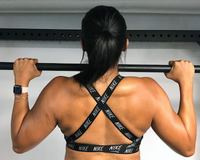The Seated Hamstring Curl
Also known as the leg curl, the seated hamstring curl is a fantastic exercise for building size and strength in your hamstrings.
Not only will this exercise increase your lower body strength, but it will help you prevent injury and improve your performance in other exercises.
In this article, we cover all you need to know about the seated hamstring curl.

Muscles Worked By The Seated Hamstring Curl
Primary Muscle Groups:
Given its name, it comes as no surprise that the seated hamstring curl primarily works the hamstrings.
Four muscles in the back of your leg comprise the hamstring: the biceps femoris (a group of two muscles: long and short head), semitendinosus, and the semimembranosus.
During this exercise, you should feel a strong contraction of these muscles.
Secondary Muscle Groups:
While the seated hamstring curl is an isolation exercise, this exercise does secondarily engage your calves.
At the beginning of the exercise motion, the calves contract to initiate the curl.
In addition, your glutes and hip flexors activate to support your hamstrings as well.
Seated Hamstring Curl Benefits
1. Bigger And Stronger Hamstrings
Unlike many eccentric hamstring exercises, the seated leg curl emphasizes the concentric portion of the exercise in which your hamstring muscle shortens.
As a result, the seated hamstring curl can help you build size more easily, as this exercise increases hamstring hypertrophy.
With greater muscle mass, not only will your lower half look more defined, but you will be able to improve your performance in other lifts such as the barbell squat and the deadlift.
2. Reduced Risk of Injury
Hamstring injuries are extremely common. A strained or torn hamstring can take weeks to recover, which will hold back your overall fitness progress.
When performed correctly, the seated hamstring curl can improve the stability of your hamstrings, as well as improve your lower body mind-muscle connection.
The seated hamstring curl can be an important exercise to prevent hamstring injuries and help you achieve your fitness goals.
3. Hamstring Isolation
The majority of lower body exercises recruit the hamstrings, but few isolate the hamstrings as well as the seated leg curl.
Isolation exercises can be crucial to bodybuilders, athletes, or anyone who wants to work a specific muscle group.
For example, if your quads are significantly larger than your hamstrings, you can use the seated hamstring curl to correct this muscle imbalance.
With that being said, let’s delve into the mechanics of this exercise.
How To Do The Seated Hamstring Curl
Equipment:
For this exercise, you will need a leg curl machine.
Setup:
a) Assume a sitting position in the machine with your legs fully extended. The foot pad should rest just above your ankles.
Action:
a) Contract your hamstrings to curl the pad all the way down.
b) Pause for a moment, squeeze your hamstrings hard at the bottom, then return to the starting position.
c) Repeat!
Recommendation:
If you are new to the seated hamstring curl, choose a light weight to begin and complete 3-4 sets of 12-18 reps.
If you are more comfortable with the exercise, load on some more weight and complete 10-15 reps for 3-4 sets.
Seated Hamstring Curl Mistakes
1. Rushing The Motion
The most common seated leg curl mistake is rushing through the motion. Many lifters curl the weight down and then let it spring back up very quickly.
This mistake steals your gains for two reasons. First, you eliminate the contraction of the hamstrings at the bottom of each rep. Second, you drastically reduce your time under tension.
While the seated hamstring curl does emphasize the concentric portion of the exercise, the eccentric portion cannot be neglected.
To correct this mistake, be sure to slowly return to the starting position to maximize your gains and reduce your risk of injury.
2. Lifting Too Much Weight
Another mistake made during the seated hamstring curl is simply attempting to lift too much weight.
If you feel your calves straining to dominate the motion, you are likely using too much weight.
In reality, the hamstring curl is not a “natural” lifting motion like a squat or a lunge. For that reason, you shouldn’t jump right in and load on as much weight as possible, as you could risk injury.
Your hamstrings actually respond much better to high volume training. To fix this mistake, focus on control and volume. Choose a lighter weight and work your way up as you increase the resistance over time.
Seated Hamstring Curl Variations
1. Single Leg Seated Hamstring Curl
You can also perform seated leg curls unilaterally. Simply decrease the weight, let one leg rest, and complete each rep with the same form as the standard seated hamstring curls.

2. Lying Hamstring Curl
You can also perform a hamstring curl without any heavy equipment. All you need is a dumbbell!
Begin by lying on your stomach with your legs straight out behind you. Support your upper body with your forearms.
Position a dumbbell vertically in between the arches of your feet. Then, lift your legs so the dumbbell hovers just above the floor.
Contract your hamstrings to curl the dumbbell towards your glutes. Squeeze your hamstrings hard at the top and pause for a moment. Slowly return to the starting position and repeat!

3. Standing Hamstring Curl
Don’t like sitting or lying on your stomach? Standing hamstring curls are for you!
To begin, assume a standing position and place one foot behind the other with your heel off the ground.
Contract your hamstring to bring your trail foot towards your buttocks. Slowly return to the starting position and repeat!


Seated Hamstring Curl Alternatives
If you enjoyed the seated hamstring curl, check out these alternative hamstring exercises to improve your lower body training:
1. Nordic Hamstring Curl
Begin by kneeling on both knees with your back straight. Secure your ankles with a piece of equipment or have your partner hold them in place. Tighten your hamstrings, glutes, and abs.
Keeping your back straight, slowly lean forward until you reach the floor. *Note — most people cannot control the movement all the way down. Lean forward as far as you can until you fall forward and catch yourself.
Squeeze your hamstrings to raise your body back to the starting position. Feel free to push yourself up off the ground if you need an initial boost.
Squeeze hamstrings and glutes hard at the top to maximize the contraction. Repeat!

2. Glute Ham Raise
Position your feet firmly against the foot plate and allow your calves to press against the ankle hooks. Your knees should be slightly behind or exactly on the knee pads.
Start with your upper body perpendicular to the ground. Feel as though you are able to draw a vertical line from your head to your knees.
Tighten your hamstrings, glutes, and abs. Slowly lower yourself until your body is parallel to the floor. Next, press your toes into the foot plate and raise your body using your hamstrings (and some help from your glutes).
Squeeze hamstrings and glutes hard at the top to maximize contraction. Slowly lower yourself back down and repeat!

3. Dumbbell Romanian Deadlift
Assume a standing position with your feet shoulder width apart and hold the dumbbells with your palms facing inward. Engage your core, bring your shoulder blades together, and keep your chest held high.
With a slight bend in your knees, hinge at the waist with a straight back and lower the weights towards the ground. You should feel a deep stretch in your hamstrings as your hips move backwards.
Now, reverse the motion as you return to the standing position and squeeze your glutes. Maintain tightness in your core and repeat!

Looking For A Full Hamstring Workout?
Follow along to this intense 5-minute at home hamstring workout!
Join The Invasion!
This Anabolic Aliens membership will grant you access to workout classes, rehab programs, diet plans, and more exclusive content to help you achieve sustainable success!











